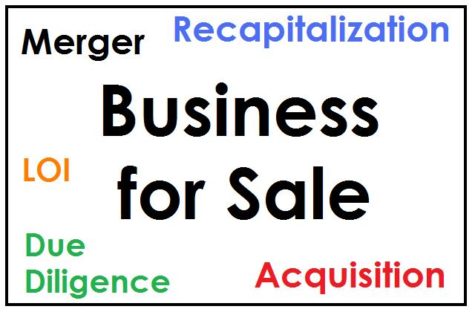The owner of a privately held business has made the decision to sell their company. What is the process for this? What steps should be taken and in what order?
Here is an outline of the key steps in the sales process.
The process is basically the same for deals of all sizes and types. It assumes the business that is being sold has value. The goal is to start an auction, if at all possible.
Should the business be troubled in some way, the sales materials will be more targeted to a specific buyer(s) and will focus on them.
- There are many reasons why an owner decides to sell a business. Perhaps they are getting ready to retire. Perhaps they are just burned-out. In larger businesses, maybe the reasons are strategic to the business. In any event, an analysis should be conducted that considers the reasons for the sale and the goals to be achieved.
- Determine the business value. Once the decision to sell is made, the owner/equity stakeholders should conduct a business valuation. An outside, independent business valuator should be engaged. Even very large, multi-national Fortune 500 companies will hire a business valuator to do this, in conjunction with their internal staff. Often the business valuator is part of a larger investment bank that hopes to eventually get the investment banking fees. Sometimes, the valuator is not part of an investment bank. But the key point is that an outsider is brought in to help.
Often the business for sale has strong growth potential, but that could only be realized through capital investment. That capital may not be available, for whatever reason. If this is the situation, the business may be very salable. - Prepare the analysis describing why the company is for sale. This may not even be shown to anyone but the business owner but does clarify the reasons for the sale in the mind of the owner.
- Clean up the company and especially have the financial statements in excellent condition. This needs to be done early in the process. Cleaning up the company means fixing any obvious operational issues. Even clean up the facilities – make them presentable. Take away any excuse that the buyer may use to lower the price. Especially make sure the financial statements are pristine. Financials in great condition will make the process go much smoother. The seller absolutely wants to avoid having to make changes or adjustments to the financial statements after the buyer is looking at the company. If the financial statements are in poor condition, to begin with, it may take up to three months to fix them.
- Assemble the sales team. No owner of a privately held business should try to sell their company on their own. There should be a ready-to-go team of attorneys, accountants, business valuators, and a business intermediary. Should the owner need it, a personal financial planner might be included in this group.
- Prepare the sales materials. This means the offering memorandum and a “teaser” document. When finished, the memorandum will contain at least three years of financial information and a current-year outlook. Projections beyond that will not be included in the memorandum but delivered later to serious buyers. The teaser document is a 1-2 page description of the company but with the identity hidden. If a potential buyer is interested, they will sign a non-disclosure agreement and receive the offering memorandum.
- Other preparations. Besides the above documents, a management presentation will be prepared to be used when potential (serious) buyers visit. Typically, the presentation will be made by not only the seller but also the managers who will remain with the business. A secured data room may be set up or the data can be downloaded into a CD if it isn’t sensitive.
- The sales process begins. The sales team, including the intermediary, will identify the most likely buyers. Most of these will be well-known to the sales team. The top potential buyers will be the “strategics”. These are industry competitors who might be interested in the business for sale, in order to strengthen their base business. Others to be contacted include investment bankers, private equity firms, and other industry participants. At this point, time is very important. The seller wants the sale to happen quickly. If a party is interested after the call, the “teaser” or deal summary is sent. If interest continues, a non-disclosure agreement is signed. After signing the NDA, the offering memorandum is delivered. The number contacted can be perhaps 25-30 potential buyers are initially contacted. Then ten sign the NDA. Maybe five receive the offering memorandum. Often, a purchase agreement prepared by the seller is sent.
- Remember – always keep confidentiality throughout the whole process! See my prior posts on this.
- Receiving the offers. The small number of potential buyers that receive the offering memorandum should be given no more than 2-3 weeks to perform their initial due diligence, visit the company, and hear the management presentation. The goal is to get them to issue a Letter of Intent (also called a term sheet or LOI). Of course, the seller wants an LOI right away and the buyer wants time to consider the acquisition.
- At this time, the seller could have interest from several buyers. Negotiations are begun with the most attractive potential buyer. The others are put on hold so that is the first set of negotiations do not work out, they can be re-contacted.
- A word about price. Of course, the seller wants to get the highest price in this process. But many other factors should be considered also, including transition management agreements, and contingency payments/penalties. Maybe most especially is whether the buyer will be able to support and sustain the business. This could be extremely important if a business unit is being sold and will continue to interact with the seller’s remaining business.
- Accept the final offer and go through the closing. I have written about the closing in earlier posts.
The process listed above is a classic auction. The goal is to sell the business, do it quickly, have it clean avoid post-closing adjustments. Of course, not all business sales will go through this process exactly, and this is pretty much a template. But it gives you an idea of what to expect.



